Black elderberry Black Lays: cultivation and application on the site
Many gardeners strive to get a black elderberry Black Lace in their personal plot. It is the highlight of the original ornamental trees. It attracts with the extraordinary color of the leaf plate, inflorescences and berries. But before planting, you should familiarize yourself with the conditions for growing and reproducing an interesting shrub.
Content:
- Shrub description
- Growing conditions
- Reproduction and planting
- Care Tips
- Application in landscape design
Shrub description
Black Elderberry Black Lace has a second name - in a simple way "Eve". It belongs to plants with vertical growth, wide and large shrubs. His leaves fall off in the winter. Its volumes reach 2.5 meters in height and 2 meters in width. The foliage of an exotic plant is not arranged in pairs - opposite. It has a dark purple, cherry hue, close to black. The leaf blades shine brightly in the sunlight, giving off a gloss.
Blooming of buds begins from the first months of the coming spring. The budding period lasts throughout the summer and until late autumn. Inflorescences are represented by a milky pink shade, gentle tone. With the passage of time and fading, they change color to cream with a white tint.
The shrub has a pronounced lemon scent that spreads over a wide area.
After flowering, fruits appear on the plant. They are black and red bubbles, glossy tone, shining in the sunlight. Full ripening occurs in the last days of September - early October.
The inside of the fruit contains a large amount of acid. Therefore, many housewives use berries to clean various surfaces contaminated with fatty masses. In addition, the fruits are used to make jams, compotes, fresh juices, as well as medicines, in the form of decoctions and tinctures. But in most cases, gardeners do not use the fruits, considering the shrub to be an ornamental plant, and not edible fruit. Several places are considered its homeland - Europe, Asia Minor and the Caucasus. Likes to grow near populated areas, near the walls of houses, so that the walls protect her from piercing winds.
Growing conditions
For cultivation, you need to find the best place. For this, the eastern side or the northern edge of the site is suitable. In order for the shrub to be well and efficiently pollinated, it is desirable that other plants blooming in the same period are located nearby.
In most cases, black elderberry is an unpretentious shrub. It grows in various soils and does not require any special specific care. It can grow on poor soils, but most of all prefers limestone and sandy soils, as well as on semi-dry mixtures. Does not distinguish between advantages for growing in heavy or medium soil substrates.
The only requirement for good growth and rapid growth is a high content of nitrogen fertilizers in the soil.
It can grow both in slightly acidic soil at a pH level of 5.5 to neutral (pH 7.0). The tree likes to be in the direct rays of the luminary. She is not affected by ultraviolet radiation, so she is not afraid of burns.The shrub can be placed in the shade, but then rapid growth is not expected. If the plant gets at least 2-3 hours of direct light, then moderate growth is possible.
Thus, planting a plant in a specific soil, with strict observance acidity not required. Elder grows quickly, filling the entire space with spreading branches. Therefore, among the people of these data, the type of shrub is considered weedy. But at the same time, if you follow it and cut it off in time, then its decorative properties will be appreciated and considered the highlight of the entire personal plot.
Reproduction and planting
Reproduction of black elderberry occurs with the help of seedlings, seeds and branches:
- The most difficult cultivation method is the seedling method. They should be specially pretreated, planted in disinfected soil and greenhouse conditions for rapid germination should be fulfilled. Not all sprouted sprouts survive until they are transplanted into a large container. The plant is planted in a new place of residence at 50 cm in height. Only after a year it will be possible to plant it in open ground for permanent residence. This method of growing Black Lays is the most laborious and costly, not only in terms of strength, but also in time. Seeds do not always transfer maternal qualities to new seedlings, therefore it is recommended to grow young plants either by cuttings or by branches.
- Cuttings are recommended to be cut from the mother bush either in the fall before going on winter holidays, or in early spring. The seedling should not exceed 25 cm in height, while on the trunk it is necessary that at least 2 healthy buds are located. Such cuttings are planted temporarily in a specially designated flowerpot with damp soil, until the seedling starts up young roots. In the spring, it is recommended to plant the plant in a new place of residence, for quick build-up root system and green aboveground mass.
- It is easiest to root with bends. A suitable branch is selected, located at the base of the shrub. A small trench is dug into the soil. The branch is bent to the ground so that the shoot touches the ground in the chosen place. This section of the branch is attached to the soil substrate, and sprinkled with earth on top. The procedure is best performed in the first spring months. Along with the tree, water the young stalk. It will take root over the summer, and in the fall it will only be necessary to separate the young seedling from the mother bush, cutting off at the base of the cutting.
Planting should be carried out either in the spring or in the fall 30-45 days before the onset of the first cold weather. The weather should be warm, calm. It is advisable if it is cloudy and afterwards it rains.
A recess is being prepared in the ground, completely corresponding to the root system of the black elderberry. It must be at least 50 cm in diameter. The following fertilizers should be poured into the pit for the rapid rooting of a young seedling and its active growth:
- 8 kg of humus
- 50 gr. potash fertilizer
- 50 gr. phosphorus
The mixture must be mixed with garden soil and brought into the depression to the middle of the hole. Then a seedling is placed on the embankment. If a transplant is made in the form of a transshipment, then a clod of earth is placed in the pit. Otherwise, you need to carefully straighten the root system, while first checking the roots for damage, mold or decay.
The plant deepens in such a way that the root collar remains in the fresh air. For initial support, you can use a small stake, the height of which should not exceed the lower branches. After planting, the ground should be slightly tamped and the bush should be thoroughly watered.
Care Tips
Black Elderberry Black Lace is not whimsical in leaving:
- It does not need to be watered for several days, it can stoically endure drought. But if it is moistened with a large amount of nutritious moisture, it will be delighted and respond with wide open leaves and active flowering, as well as a rich aroma.If there is no long precipitation in the summer, then the elderberry should be watered on its own. It is recommended to moisten the plant until the root system detects groundwater.
- A young plant, in order not to water often, should mulch... For this, chopped tree bark, well-dried straw or sawdust are suitable. In this case, the plant will not give up moisture for a long period of time.
- Loosening is definitely recommended. As a result of the procedure, the required amount of oxygen will be supplied to the rhizomes. In addition, the incoming nutrient fluid will not stagnate on the surface, but quickly penetrate deep into the soil substrate, saturating the root system.
- You need to fertilize the tree no more than once a year. The procedure is carried out in early spring. At the same time you need to add to the soil mineral fertilizers, and organic... For the latter, suitable compost and rotted manure. Organic application should be carried out either before flowering or after flowering. It is especially important to feed the bush with nitrogen-containing substances in the spring. Thanks to this fertilization, the shrub will grow even more and more massive.
Application in landscape design
As an ornamental shrub, both specifically bred varieties and wild species are used. It is excellently used as hedges due to the fact that it grows rapidly. If shaped with constant trimming, it will look neat and eye-catching with its interesting appearance.
Some gardeners distinguish this tree from all other species. It is located away from other shrubs, suggesting a stunning effect during flowering.
If the shrub is formed, then the black elderberry can be placed not only as a hedge, but also to create mixborders or flower beds with different levels.
In addition, the black elderberry Black Lace can be used on alpine slides and in areas with evergreens.
It is imperative to carry out formative pruning. If you follow a simple procedure, then an interesting plant with the shape of a ball or columnar shrub may appear on the site. The main thing is to apply imagination and experiment, especially if this allows the active growth and spreading of an exotic tree.
Thus, the black elderberry Black Lace has an interesting color range of leaf plates, spreads a fragrant smell over large areas and does not require specific maintenance. It is actively used for landing in various combinations.
More information can be found in the video:



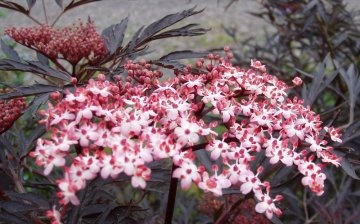
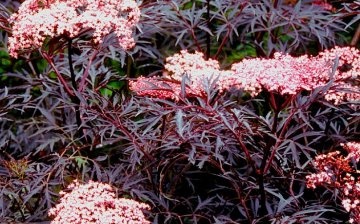
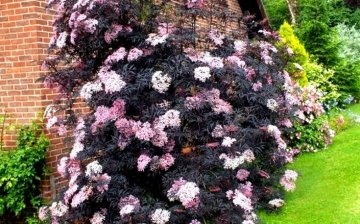
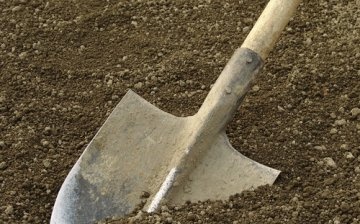
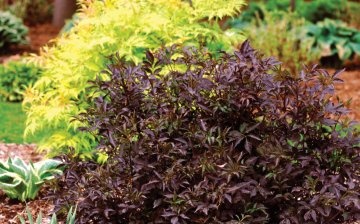
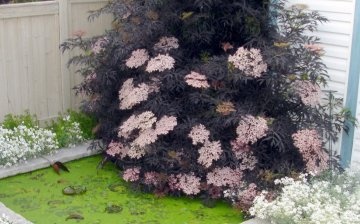







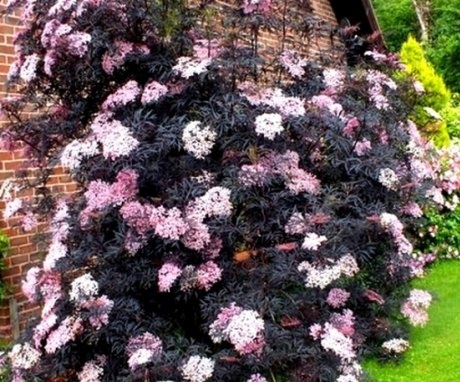
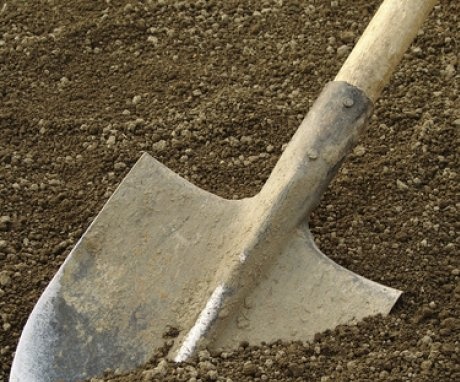
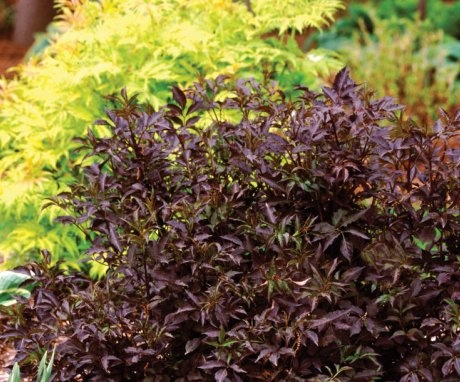
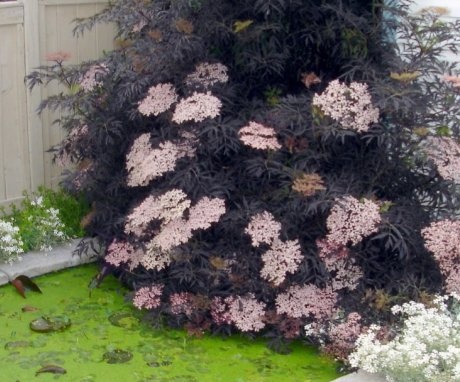
Elderberry Black Lays grows in our garden, I really like how the dark foliage contrasts with light flowers. The berries stay on the plant for a long time, up to the snowfall.
We use elderberry flowers from insects in the house, because they do not like its smell. The plucked flowers were laid out in the wardrobes and placed behind the cupboards in the kitchen. Elderberry on the site has not yet been grown, but tore on the street.